Morphological differentiation in floral buds of Camellia azalea Wei
LI Xinlei*1,2, LI Jiyuan1, SUN Zhenyuan2, YIN Hengfu1, FAN Zhengqi1
1Research Institute of Subtropical Forestry, Chinese Academy of Forestry, Fuyang 311400, China;
2Research Institute of Forestry, Chinese Academy of Forestry, Beijing 10091, China
* Author for correspondence, e-mail: lixinlei2020@163.com
Introduction
As one of the top ten traditional famous flowers, Camellia is also a precious flower in the world and plays an important role in flower production. Florescence is one of the main ornamental characteristics. Study on the flower bud differentiation is the basis for flowering regulation, quality guarantee and breeding (Wang et al, 2002). The flower bud differentiation has been observed on C. oleifera Abel and some varieties of C. Japonica L. (Yuan et al, 2011; Ye et al, 1989). C.azalea Wei, also known as C. changii Ye, is an endemic and endangered species, (Wang et al, 2004). It distributed only in the E’huangzhang provincial nature reserve of Guangdong, which is located in Yangchun city, Guangdong province (Wei, 1986; Zhang et al, 1998). C. azalea Wei has a long flowering period and the main florescence is from April to December. In appropriate cultivation conditions, C. azalea Wei could bloom throughout the whole year, the best blooming time is during summer and autumn, and this unique property make this variety a good parent (Gao et al, 2005). The flower bud morphological differentiation of C. azalea Wei has not been studied until now. So, in order to provide a theoretical basis for flowering regulation and breeding, C. azalea Wei was used to study the morphological differentiation of flower buds.
Materials and Methods
Plant material
The fresh flower buds of different developmental stages of C. azalea were collected from May to September in 2011, which were planted in Research Institute of Subtropical Forestry, Chinese Academy of Forestry.
Methods
The collected buds were fixed in 50% FAA fixative solution, and were stored in 4C refrigerator. Buds sections of C. azalea with the thickness of 8 um were made by paraffin cut method. Sections were dyed in safranine and fast green double dyeing solution, and were sealed with Canada gum. Sections were observed by microscope, and photographs were then taken. Length and width of buds were measured by vernier caliper, and the weight recorded before slice production. Morphology of flower buds was also observed and recorded.
Results
Morphology and structure of flower of C. azalea
Flowers of C. azalea are bright red, 6.0~14.0 cm in diameter, and borne singly or clustered at the tip of the shoots. Bracts and sepals are persistent, rather leathery, green or slightly red when near to petals, hemicycle and smaller at the lower end, long circular and gradually increasing in size. Petals are 6~9, 4.0~7.0 cm long, 2.0~4.0 cm wide, obovate to obcordate-lanceolate, slightly cleft at the tip, free at the base. Stamens on the outside are 2.0~2.5 cm long, fusing at the base into a tube, but those on the inside are free and shorter. Anthers are yellow, and anther chambers have a longitudinal crack. Ovaries are ovoid and glabrous, 2~4 locules, 3 ovules in every locules. Styles are 2.0 cm long, with 2~4 cracks dividing the top and fused at the lower end. Capsules are ovoid, 2.0~2.5 cm long, 2.0 cm in diameter, glabrous, 2~4 locules, 1~3 ovoid seeds in every locules. The species blooms from April to December, and best flowering time is from June to September in the region of origin, then from June to October, best flowering time July to August, in Fuyang city, Zhejiang province.
The process and main characters of flower bud differentiation of C. azalea
The morphological characters and paraffin cut methods were used to observe the developing process of the flower bud differentiation of C. azalea, and the correlation between flower bud differentiation and its external morphology was analyzed. The results showed that the flower bud differentiation of C. azalea, progresses in succession from May to September, and the different developmental stages of the flower bud can be observed. The time of flower bud differentiation depends on environmental conditions, and the growth and development of C.azalea. According to the morphological changes of the vegetation cone, the process of flower bud differentiation could be divided into six phases: before differentiation, bract differentiation phase, sepal differentiation phase, petal differentiation phase, stamen differentiation phase and pistil differentiation phase.
Before differentiation: Shoots begin to elongate with the germination of buds, and meristem cells of flower bud become active. Tissue at the growing point divides rapidly, and then vegetation cone sticks up. With gradual elongation and increase, the vegetation cone changes from tip shape to round shape, and its diameter also gradually increases, forming a prominent protuberance shape(Fig. 1A). At this stage, the structures of flower bud and vegetative bud are similar, and their morphological characters have no significant difference.
Bract differentiation phase: Vegetation cone inside of flower bud resembles a ball, and its superficial cells deeply stained are divided in the centre. The protruding vegetation cone rapidly increases and expands in volume(Fig.1B). With the continuously expanding of vegetation cone, oval protuberances called bract primordium gradually form at the edge of it(Fig.1C).
Sepal differentiation phase: The top of the enlarged vegetation cone gradually changes from oblate shape to flat shape, and then its top depresses, forming a protuberance around it. The protuberance grows continuously and expands with strong division and elongation of cells which rapidly divide under the protuberance, and then forms sepal primordium which develop into the sepals(Fig.1D,E).
Petal differentiation phase: With the development of the bud, elongated sepal primordium broadens and bends inwards. New protuberances gradually form at the top of vegetation cone inside the sepal primordium, that are called petal primordium(Fig.1F). Petal primordium soon become band shaped with rapid growth so that the increase of length is faster than that of width(Fig.1G), which gradually develops into the petal.
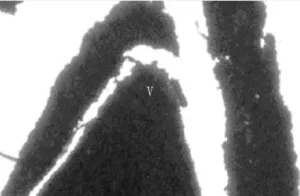 |
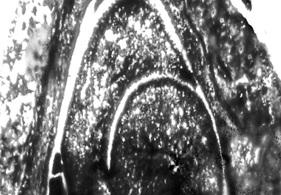 |
 |
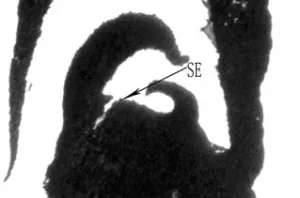 |
 |
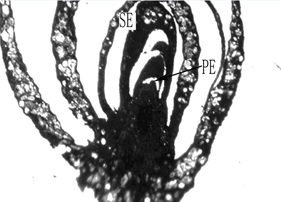 |
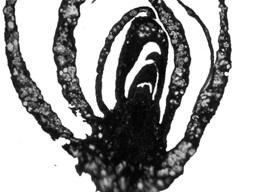 |
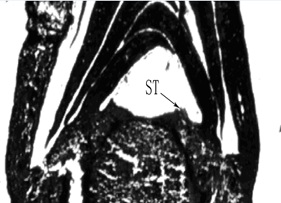 |
 |
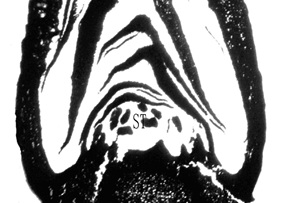 |
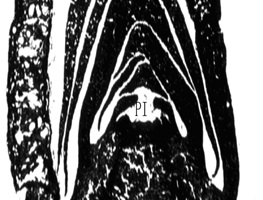 |
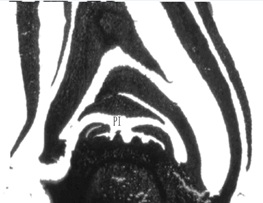 |
Stamen differentiation phase: The centre of the sepal primordium increases and broadens, so that the upper and lower diameter of the vegetation cone is nearly the same. With the depression of the top of the vegetation cone, new protuberances appear inside the petal primordium, and stamen primordium begins to form(Fig.1H). More protuberances gradually appear at the top of vegetation cone, so stamen primordium continuously forms and elongates(Fig.1I). Following the appearance of anthers and filaments, the internal structure differentiates that will eventually develop into stamens groups(Fig. 1J).
Pistil differentiation phase: Following the development of stamens, the vegetation cone inside of the stamen primordium rises and forms pistil primordium(Fig. 1K). Newly formed pistil primordium grows from the periphery to the centre at the bottom of vegetation cone, that on the outside bends inwards(Fig. 1L). Subsequently, pistil primordium at the centre elongates, covering the vegetation cone(Fig. 1M). Fully differentiated buds have round sepals and petals, many stamens and pistils(Fig. 1N).
The flower bud differentiation course and external morphology of C. azalea
While the flower bud of C. azalea is differentiating, the external morphology is also changing. The correspondence between bud differentiation and appearance shape is shown in Table 1. With the flower bud differentiation, the length and width of bud are increasing gradually, and the increasing rate of bud length is larger than that of bud width. Bud weight is also increasing and the rate is gradually increased. External morphology is changing constantly with the flower bud differentiation. Before differentiation, the flower bud is wrapped in a layer of hard sheath-like scales, which are closely compacted and have high hornification. In the stage of bract differentiation, the scales gradually began to crack. In the stage of sepal differentiation, the degree of bud scales cracking increases into V-shape. In the stage of petal differentiation, the flower bud enlarges, and the bud tip protrudes from the scales. In the stage of stamen differentiation, the bud enlarges and more length is outside of the scales. In the stage of pistil differentiation, the bud enlarges continuously, while the scales degenerate and can be easily stripped away. During the stage of carpel differentiation, the scales become smaller. When the thick scales and membranous bracts are stripped out, red small alabastrum could be found.
Table1 The flower bud differentiation course and appearance configuration of C. azalea Wei
|
Differentiation phase |
Average length of buds(mm) |
Average width of buds(mm) |
Length/ width |
Average weight of buds(g) |
|
Before differentiation |
1.23 |
1.70 |
0.73 |
0.0008 |
|
Bract differentiation phase |
1.82 |
1.84 |
0.99 |
0.0017 |
|
Sepal differentiation phase |
2.42 |
2.06 |
1.17 |
0.0066 |
|
Petal differentiation phase |
3.80 |
2.49 |
1.53 |
0.0120 |
|
Stamen differentiation phase |
5.25 |
3.08 |
1.71 |
0.0328 |
|
Pistil differentiation phase |
6.54 |
3.37 |
1.94 |
0.0426 |
|
Carpel differentiation phase |
7.65 |
3.50 |
2.19 |
0.0816 |
Discussion
The division of flower bud morphological differentiation of ornamental plants is different. For example, the developing process of the flower bud differentiation of Osmanthus fragrans ‘Houban Jingui’ was divided into seven phases: bract differentiation phase, inflorescence primordium differentiation phase, single flower primordia differentiation phase, sepal differentiation phase of top flower, petal differentiation phase, stamen differentiation phase and pistil differentiation phase (Wang et al, 2002). The development of flower bud differentiation of C. oleifera Able ‘Xianglin I’ could be divided into six stages: pre-differentiation, sepal formation, petal formation, stamen and pistil formation, ovary and anther formation, and stamen and pistil maturation (Yuan et al, 2011). The division of different varieties of C. japonica L. also varies: single and semi-double flowered cultivars were divided into flower primordium, sepal primordium, petal primordium, stamen primordium and pistil primordium differentiation phase; anemone form and double flowered cultivars were divided into flower primordium, sepal primordium, petal primordium, stamen primordium, pistil primordium, stamen petalody and pistil petalody differentiation phase (Ye et al, 1989). The process of flower bud differentiation of C. azalea Wei was divided into six phases: before differentiation, bract differentiation phase, sepal differentiation phase, petal differentiation phase, stamen differentiation phase and pistil differentiation phase. The results of flower bud differentiation of Rosa persica Michx ex Juss are the same (He et al, 2005). The difference of flower bud morphological differentiation of different plants may be mainly decided by their different flower bud structure and flowering characteristics.
Camellia flower bud differentiation begins at the top or leaf axil after the formation of spring shoot. The stage of bud enlargement is from July to August and the flowering period is from October to middle May next year (Gao et al, 2007). The flower bud differentiation of C. oleifera Able and C. japonica L. begins from late May to late June (Yuan et al, 2011; Ye et al, 1989). In Fuyang city of Zhejiang province, the flower bud of C. azalea Wei begins to differentiate in May and could last one month with the temperature more than 20C on average. The flower bud differentiation continues from May to September, and the flower buds of different developmental stages can be observed. During this period, as long as the necessary nutrients and environmental conditions are suitable, the flower bud of C. azalea Wei can differentiate. Generally speaking, the blooming period of Camellia is not more than one month, but the flowering time of C. azalea Wei is from middle June to late October in Fuyang city of Zhejiang province, and from April to December in Yangchun city of Guangdong province. The flowering time is earlier and longer in the country of origin; that may be because of the temperature. Higher temperature could promote flower bud differentiate and growth.
Flower buds begin to differentiate after the new shoots of Camellia plants mature (Ye et al, 1989). From May to September, the vegetative growth and reproductive growth of C. azalea Wei are carried out simultaneously. So, there is different differentiation of leaf buds and flower buds on the same plants. Therefore, the growth and development characteristics of C. azalea Wei are different from the other Camellia plants. The process of the flower bud differentiation could be identified by the external morphology according to the stable corresponding relationship between them. However, whether the relationship is applicable to all species of Camellia, remains to be further studied.
References
Gao J., Parks C. R., Du Y.2005. Collected species of genus Camellia an illustrate outline , Hangzhou: Zhejiang Science & Technology Press, 34-35.
Gao J., Su Y., Hu X.2007. The identification and appreciation of the world’s outstanding Camellias, Hangzhou: Zhejiang Science & Technology Press,345.
He H., Zhu J., Gao Q., Ueda Yoshihiro, Gao J., Hu J. 2005. Morphological differentiation of the flower bud of Rosa persica. Acta Horticulturae Sinica, 32(2):331-334.
Wang C., Gao L., Lu D., Huang Y. 2002. A study on morphological differentiation of flower bud of Osmanthus fragrans‘Houban Jingui’. Acta Horticulturae Sinica, 29(1):52-56.
Wang S., Xie Y. 2004. China species red list .Beijing: Higher Education Press, 362.
Wei Z.1986. New species of Camellia from China. Bulletin of Botanical Research, 6(4):141-143.
Ye M., Jin X., Wang C., He X.1989. Studies on morphological differentiation of flower bud of Camellia japonica L. cultivar and analysis on the formation of flower forms. Acta Horticulturae Sinica, 29(1):52-56.
Yuan D., Zhou F., Tan X., He C., Yuan J., Fan X. 2011. Flower bud differentiation and development of male and female gametophytes in Camellia oleifera. Journal of Central South University of Forestry & Technology, 29(1):52-56.
Zhang H., Ren X.1998. Flora Reipublicae Popularis Sinicae, volume 49, part 3.Beijing: Science Press,7.
Web design by Tribal Systems
